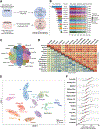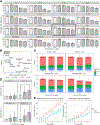Comprehensive Analysis of Metabolic Isozyme Targets in Cancer
- PMID: 35247885
- PMCID: PMC10883296
- DOI: 10.1158/0008-5472.CAN-21-3983
Comprehensive Analysis of Metabolic Isozyme Targets in Cancer
Abstract
Metabolic reprogramming is a hallmark of malignant transformation, and loss of isozyme diversity (LID) contributes to this process. Isozymes are distinct proteins that catalyze the same enzymatic reaction but can have different kinetic characteristics, subcellular localization, and tissue specificity. Cancer-dominant isozymes that catalyze rate-limiting reactions in critical metabolic processes represent potential therapeutic targets. Here, we examined the isozyme expression patterns of 1,319 enzymatic reactions in 14 cancer types and their matching normal tissues using The Cancer Genome Atlas mRNA expression data to identify isozymes that become cancer-dominant. Of the reactions analyzed, 357 demonstrated LID in at least one cancer type. Assessment of the expression patterns in over 600 cell lines in the Cancer Cell Line Encyclopedia showed that these reactions reflect cellular changes instead of differences in tissue composition; 50% of the LID-affected isozymes showed cancer-dominant expression in the corresponding cell lines. The functional importance of the cancer-dominant isozymes was assessed in genome-wide CRISPR and RNAi loss-of-function screens: 17% were critical for cell proliferation, indicating their potential as therapeutic targets. Lists of prioritized novel metabolic targets were developed for 14 cancer types; the most broadly shared and functionally validated target was acetyl-CoA carboxylase 1 (ACC1). Small molecule inhibition of ACC reduced breast cancer viability in vitro and suppressed tumor growth in cell line- and patient-derived xenografts in vivo. Evaluation of the effects of drug treatment revealed significant metabolic and transcriptional perturbations. Overall, this systematic analysis of isozyme expression patterns elucidates an important aspect of cancer metabolic plasticity and reveals putative metabolic vulnerabilities.
Significance: This study exploits the loss of metabolic isozyme diversity common in cancer and reveals a rich pool of potential therapeutic targets that will allow the repurposing of existing inhibitors for anticancer therapy. See related commentary by Kehinde and Parker, p. 1695.
©2022 American Association for Cancer Research.
Figures







Comment in
-
No Back-up Plan: Loss of Isozyme Diversity as a Promising Therapeutic Strategy for Cancer.Cancer Res. 2022 May 3;82(9):1695-1697. doi: 10.1158/0008-5472.CAN-22-0855. Cancer Res. 2022. PMID: 35502550
References
-
- Svensson RU, Shaw RJ. Cancer metabolism: tumor friend or foe. Nature 2012; 485:590–1. - PubMed
Publication types
MeSH terms
Substances
Grants and funding
LinkOut - more resources
Full Text Sources
Medical
Miscellaneous

